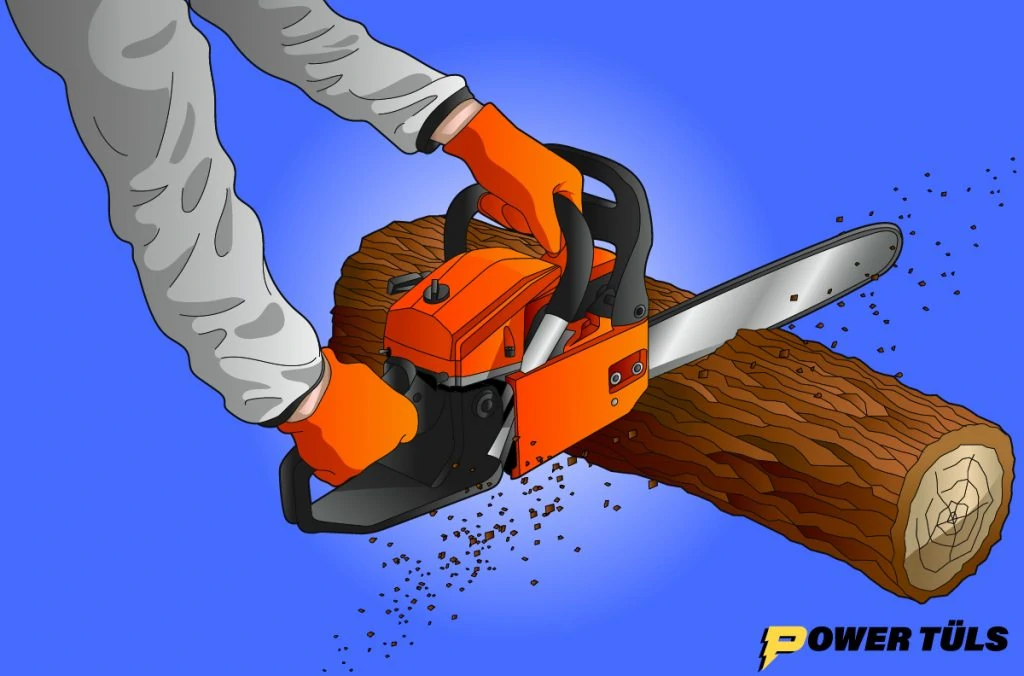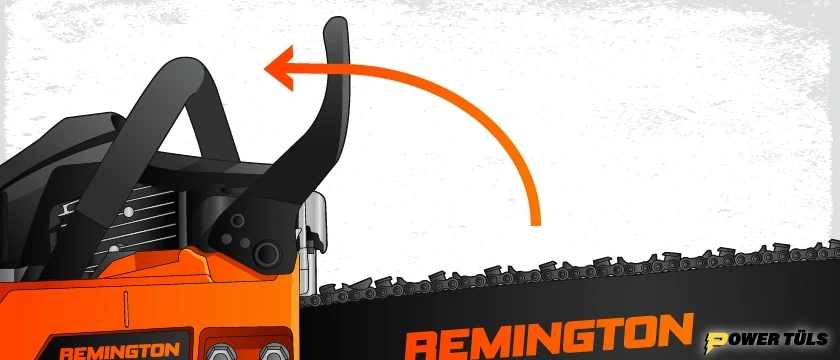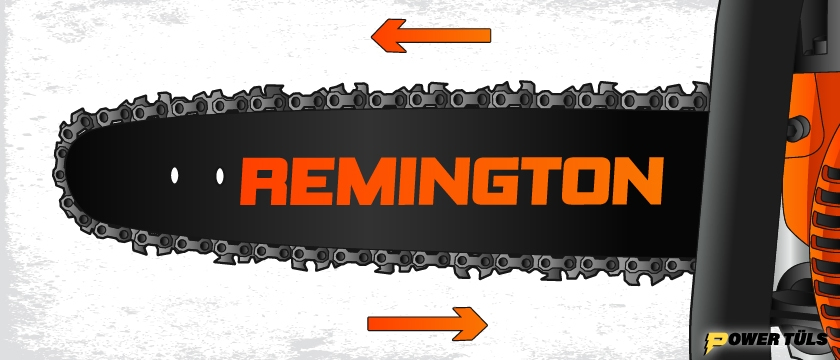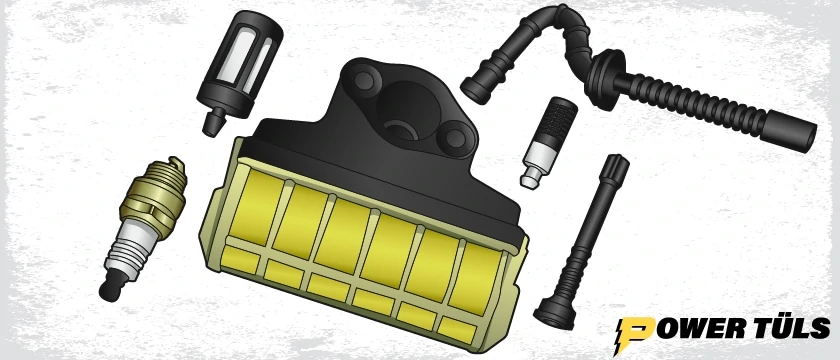When the chainsaw was invented, it didn’t take them long to change the way logging was done forever.
Professionals began relying on them to make their living and they were able to cut bigger trees at a faster pace. The problem is that this type of hot-rod performance can be intimidating for the average homeowner but we’d like to change that.
In this article, we’re going to going to show you how to use a chainsaw safely, specifically for gas chainsaws. We’ll teach you how to protect yourself against accidents so you can enjoy the power and capability these saws can offer while minimizing risks.
1. Suit up with safety gear
Before you even pick up a saw, you need to gear up with the safety equipment that will help you avoid a serious injury while tree felling. This includes chaps, hardhat, eyewear, ear protection, a sturdy pair of boots, and working gloves.
Safety equipment overview
A pair of comfortable, sturdy work boots that will help you avoid rolling an ankle or slipping on a log will do the trick here. I’ve been using these ones for years and has been well worth the investment.
Along the same lines, a pair of tough work gloves will help keep your hands from getting jabbed and slashed by branches. This ensures that you’ll be able to keep a solid grip on your saw in the event that it kicks back or you slip.
As for chaps, a good set of cut-resistant chaps can be the difference between a scary moment and a life-ending accident. Cut-resistant chaps have a layer of kevlar or nylon fabric that will stop a saw from cutting through your leg.
When a spinning chain makes contact with the chaps, it will rip the outer layer of the pants and then grab the nylon or kevlar sublayer. That material then gets caught in the saw, jamming it and stopping the chain from spinning. You may not be able to avoid an injury altogether, but cut-resistant chaps will seriously reduce the amount of damage the chainsaw can do to your leg.
Finally, protecting your head, eyes, and ears is important, especially over the course of a long day.
When you’re cutting wood, there are a lot of unpredictable scenarios that can cause a head injury. A falling branch, a log under twisting pressure or load that comes loose while cutting, and a number of other scenarios can be mitigated by protecting your head with a good hardhat.
Also, protecting your eyes from flying wood chips and branches with at least a pair of safety glasses is non-negotiable.
In addition to safety glasses, a pair of earmuffs will help to prevent permanently damaging your hearing from the high decibels that powerful chainsaws produce.
2. Clear and Assess Your Work Area
Before you get to work, you’ll need to be sure that your cutting area is clean and safe to work in. Move obstacles and obstructions that you can such as slippery rocks and logs, and be aware of the ones that you can’t move.
If you’re on a hill, make sure that you position yourself uphill so cut rounds don’t roll down on you. If this isn’t possible, you need to choose an angle that minimizes how affected you’ll be if it starts to roll.
This can be a very dangerous situation, so take your time and be smart about your positioning. If you can’t cut the log safely, find another one that can be cut without putting yourself in unnecessary danger.
Also, it’s worth having an escape path planned ahead of time, especially if you’re cutting standing wood like a tree. There are too many forces at work and you may only have a split second’s time to think on your feet.
Doing this ahead of time can be as important to your safety as a hardhat or cut-resistant chaps.
3. Start Your Chainsaw
If you’re geared up and your workspace has been checked over and cleared, you’re ready to start your saw.
First, check your saw to be sure that there is fuel and bar oil as well as chain oil in the respective reservoirs. A saw can’t run without fuel and cutting without bar and chain oil isn’t much fun or very efficient, plus it will shorten the life of your bar and chain.
Engage the chain brake by pushing the handle forward. You can verify that it’s working by lightly pressing the chain against a log and pushing or pulling.
If the chain moves, your brake is not working and should be serviced before you use the saw. If you’re unable to move the chain, your brake should be working like it was intended.
Now that you have fuel and oil and you know that your chain brake works, you can get your saw ready to start. If you have a fuel bulb, you’ll need to pump as many times as the saw manufacturer suggests, sometimes even more.
If the saw is cold, you’ll need to close the choke with whatever choke adjustment your particular saw comes with. If you have a decompression button, press it now to relieve the pressure in the cylinder. This will allow for easier starting, as far as both the saw and your arm are concerned.
Place the saw on a flat section on the ground and take a knee. With the bar pointed to your left, place your left hand on the handle and place your right foot partially into the trigger loop. This will secure the saw to the ground while you operate the pull-start.
Here’s a video demonstration of starting a chainsaw:
You can now pull the starter cord and adjust the choke until the saw starts. While the chain brake is still engaged, give the throttle a quick squeeze to allow the saw to rev and then come back down to idle. Congratulations, your saw is now operational.
Read our full guide on how to start a chainsaw quickly and safely.
4. Know your Types of Cuts
There are some things to be aware of in different types of cutting situations, whether it be felling large trees, removing limbs, or cutting small logs into firewood. There are also several ways to make those cuts.
Since you’re reading this article, I’ll assume that you’re pretty new to the world of woodcutting. That being said, I suggest you stick to cutting fallen logs and I’ll explain the two ways to cut them. Until you’re more familiar with the intricacies and techniques involved with chainsaws, please realize your limitations and don’t start dropping large trees in the forest unless you have an experienced woodcutter guiding you.
When cutting logs into rounds, you’ll use two parts of your chainsaw bar; the top and the bottom.
Ideally, you’ll be able to make most of your cuts with the bottom of the bar as it’s the safest and the easiest on your back and arms, but top-bar cuts are likely due to the nature of cutting fallen logs.
5. Disengage Your Chain Brake
Before you make any cuts, you’ll have to disengage the chain brake safely. To do this, get a firm grip with your left hand on the handle behind the chain brake handle.
Place the running saw on a flat, stable surface and use your right hand to pull the chain brake handle towards your left hand. When you hear and feel the chain brake snap into the run position, you’ll know the chain is free to cut with.
6. Cut Using the Bottom of the Bar
To cut using the bottom of the bar, find some stable footing and disengage your chain brake using the method we just detailed.
Now use the throttle to get the chain up to speed. Keeping your left hand on the handle behind the chain brake, slowly lower the bar onto the top of the log and allow the chain to do the work. You’ll feel the spinning chain pull the saw towards the log slightly.
Eventually, you’ll begin to anticipate that with each cut.
You’ll want the chain and weight of the saw to make the cut, so don’t press down or add pressure while the saw is cutting. Allow the chain to cut all the way through the log, taking care not to let the bar or chain come in contact with the ground after the cut is complete.
Remember, engage the chain brake when you’re not cutting.
7. Use the Top of the Bar to Cut
Some logs cannot be cut using the bottom of the bar alone, requiring you to use the top of the bar.
While this technique requires a little more physicality, it’s still a safe technique for new woodcutters. Following all the directions we detailed above, this time you’ll raise the top of the bar into the bottom of the log.
While you should still allow the chain to make the cut, you’ll have to lift the saw slightly as it cuts the log. If the saw begins to bog down or the log starts to pinch the bar, remove the saw and finish the cut from the top of the log using the bottom of the bar.
Again, engage the chain brake when you’re not cutting.
Proper Chainsaw Maintenance
Standard small engine maintenance tasks apply to chainsaws as well.
A good cleaning after use is essential. Use compressed air to blow the sawdust and dirt off of the saw. Most air filters can be cleaned with soapy water and compressed air.
Also, consider changing the spark plug each year to keep your saw running well. Don’t forget to check your fuel filter often as well. Once it gets dirty and clogged, you can forget about cutting wood until you fix it.
There are a few specialized parts on chainsaws that may need your attention from time to time. The obvious item is the saw’s chain.
Chain teeth become dull over time and will stop cutting as efficiently, making the saw work harder for longer. Learning how to sharpen your chain and tension it are great skills to master. Replacing it is the other option.
It’s actually a good idea to have a few chains on hand for each saw you own so you can replace them in the field if you dull the blade on something.
Another item unique to chainsaws is the bar. The chainsaw bar provides the track that the chain rides in. If the track becomes deformed or pinched it will wear the chain down prematurely and will definitely adversely affect cutting.
Also, chainsaw bars have oiler ports to lubricate the chain so it’s important to make sure that port is clear.
Finally, there are some small wear items you should know about in the event that they fail or need replacement. They include a drive sprocket at the saw end of the bar as well as a nose sprocket on the end. Each of these has to potential to wear out, affecting your ability to make efficient cuts, putting additional wear and tear on your saw.
Chainsaw Safety Tips
You already know what safety gear you should be wearing while operating a chainsaw, so we’d like to add to that foundation with some important tips to stay safe.
Keep these tips in mind while you’re working with your saw to minimize the chance of a serious accident. Always remember that this type of work can be unpredictable, so be alert. Also, keep a comprehensive first aid and trauma kit nearby.
After putting on your safety gear, reading and understand your owner’s manual, and clearing and assessing your workspace, follow these rules to keep safe:
- Always use an athletic stance when using a chainsaw. This is not only a stable platform for cutting safely, but it will also allow you to maneuver out of the way quickly should something go awry.
- Pay attention not only to where your saw is entering the log, but where it will exit it. Gravity is king, so if your leg or foot is under where that saw finishes its cut, you could have a looming disaster.
- Beware of kickback. This occurs when the topside of the nose of the bar comes in contact with something immovable. It’s the main way people get hurt with chainsaws. The bar will kick back at you. If your chain brake does not activate, you could find the bar and spinning chain making contact with your body. Be aware of this and avoid contacting surfaces with this part of the bar.
- Minimize the risk of kickback by using a low-kickback chain. They are inherently less aggressive so cutting will take longer, but they’re also less likely to bite into something and kick the saw back at your head.
- Always cut with two hands on the saw at all times.
- Never use a chainsaw above your head. For the same reason as above, an obstruction could kick the saw back at you, only this time gravity will be working against you as well.
- Cutting with the top of the bar pushes you away from the log while cutting with the bottom will pull you into it. They will not take you off of your feet, but be aware of these forces and brace yourself accordingly.
- Don’t modify your saw or its chain brake. This is commonplace in the professional woodcutting industry and it’s a really bad idea.
Conclusion
Some of the terms and required awareness that we’ve brought up may sound frightening, and it’s for a good reason. When things go wrong with chainsaws, they tend to go very wrong very quickly.
However, if you take the time to familiarize yourself with your saw, your safety gear, and proper handling techniques, you can minimize your chances of a situation getting out of hand.
When you need a chainsaw, there’s no other tool that will do. They can be incredibly helpful, handy, and effective. They’re versatile and powerful, and thus they demand a healthy level of respect from a safe operator.
Don’t be afraid to get to work, as there are few things less satisfying than cutting your own firewood or handling your own emergency. Just use the tips in this article as a guide on how to use a chainsaw safely.




